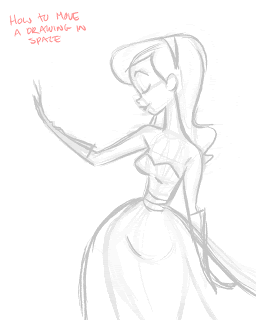
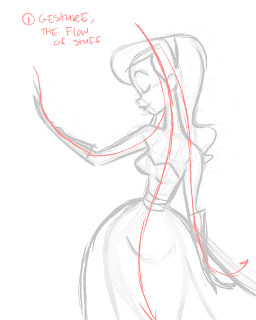
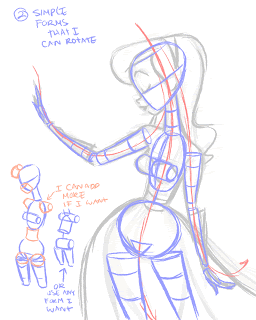
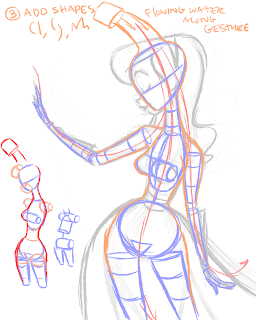
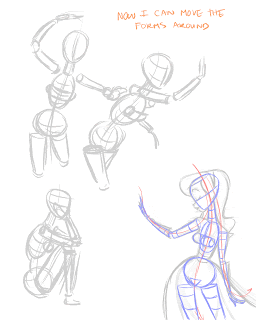
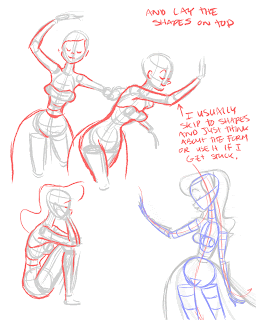
Disclaimer: in no way can you take any of this as the “right” way of doing things. I’m still learning and some of this stuff may even be wrong. I am constantly adapting and changing my approach to drawing. This is just how I think about stuff and I wanted to share it with people. Maybe it can help, maybe not.






eheh, are you working on your animation ;) ?
ReplyDeleteEverything you say here is true, a good movement in drawing is made by both volume and shapes (and for the 2D animation, I would add the lines).
Thanks for the tips Rad..I remember a friend of mine who used to make a simplified clay sculpture to his character if he has a hard time rotating it..I found that difficult for me haha!
ReplyDeleterotating face features is what I'd like to master..I do well but I have no rules..sometimes I get a stubborn angle that the character looks awkward and struggle to make it look alike from all angles....it's gets difficult with specific details not a general form for me..
Beautiful! These tips will help a lot!
ReplyDeleteXav: Not yet... I'm thinking of animating that cat woman character I drew before.
ReplyDeleteHatem: I asked an animator friend of mine about that problem and he said it is just really hard. He said to have a "do whatever it takes" mentality. He would tear off sheets of animation paper and tape them to move things, like the lasso tool in photoshop. If one of the animators got a really good drawing from a certain angle, they would all use that approach and constantly go back and try to put the characters more and more on model, almost finding the model as they went. Also, they would shift the features for certain angles just to make it look nicer, so it wouldn't actually work in 3d.
Dougmian: thanks.
Great post! I've read from your other posts about how you don't draw the forms, but for some reason it didn't compute until now with the last comment you made on the final drawing. I've been studying and drawing my forms on every drawing i make, which is probably good right now that i'm studying, but i was doing it on my sketches too and was thinking that i HAD to draw them in, but the ideas is to eventually just think about them and visualize them and not draw them in all the time right? I really appreciate these posts dude. Keep them coming :)
ReplyDeleteGod Bless,
George
gcastro: the end goal is to be a good designer. You could have the most perfectly drawn forms in the world, but if the surface features are not designed well, it will look ugly. You see this a lot with realistic paintings. Really good artist edit and design the surface, like Sargent, Leyendecker, Cornwell, and others.
ReplyDeletegreat point! I will definitely start think this way more. I love those guys' work but didn't about their use of design being the element that made them stand out. It makes sense now. Very interesting.
ReplyDeleteBefore discovering your weblog, I focussed soley on anatomy and form, as these were what my textbooks emphasised. They never mentioned anything about shape, line or design. If it weren't for your teachings I'd still be in the dark!
ReplyDeleteSW: I don't know who discovered it, but I found the principles in "the illusion of life". That was pretty much the only principle I used growing up trying to learn how to draw. Later, when I took life drawing classes, I saw how it applied to that as well, and started to learn more about the forms under the surface.
ReplyDeleteRad, my education in drawing has been the complete opposite of yours! Whereas you started with the Disney principles, I started with anatomy, thinking it was all I needed to know ('cause I became interested in art through the '90s Image superhero comics, which were all about anatomy). I read some of the Illusion of Life from the seven camels site, but the info didn't sink in until I read your posts. Wish I'd had access to your teachings earlier, as it could've saved me lots of time and frustration!
ReplyDeleteExcellent tutorials, as always! I've been recommending your blog around the halls at Art Center in Pasadena, and it seems people are getting a lot out of it. I love how you're teaching solid animation principles, which many expensive art schools tend to lack. Thank you!
ReplyDeleteThank you sir.
ReplyDeletewow, you should do some video demos
ReplyDeleteDavid: thanks. You guys have some great teachers there who I have learned a lot from.
ReplyDeletegreat solid post! as always. I was gonna ask the same questions that everybody seems have already asked. Can I assume correctly that in the beginning you're starting out doing shape work and later on studying the form to support those shapes?
ReplyDeleteIvan: Shape is the most important thing to make your drawing look nice, but it's really difficult to move it around. Form is more of a helpful tool you can learn and use. As for what to do first or what to do second, that is completely up to the artist. Some great artist just start with a perfectly drawn eye and work their way out, some draw all the forms first, some just work with shapes, some draw a wild mess of scribbles and try to turn it into something. I would say try everything and see what you like. I constantly try new approches.
ReplyDeletethat's a great description of form and shape. it makes things much clearer, both in the post and the last comment you put for ivan. Thanks! :)
ReplyDeleteTried it, applied it and loved it. Redrew a scetch from this afternoon using your aproach and its quite a huge improvement. So once again, thank you for sorting a bunch of things out and making pieces click together.
ReplyDeleteCool Rad. Those little shape design symbols on step three that I learned in your class have been the biggest help to me.
ReplyDeleteI love this blog. Your how-tos are so insightful and really helpful.
ReplyDeleteHi Rad, I had a general question. You said you basically start with gesture and shape first, and then think about the form rather than actually drawing it. I guess form is implied, like we describe it in how we overlap the shapes, right? I ask because I personally have a really hard time building a drawing starting with forms. I used to get form confused with shape, and would then wonder how Disney animators would start with a circle for a chest and then end up with that triangle shape that Aladdin has (for example).
ReplyDeleteAnyways, a little long winded, but you would say in general, the simplest shapes that make up the character first, with an awareness of the forms underneath, right?
David: When you are learning you can isolate each concept and just work on them. For instance, if you have a problem with form just draw form for a little bit. If you have a problem with shape, just draw shape, etc. Eventually you will find a personal way to put everything together, and each artist does it differently.
ReplyDeleteشركة نقل اثاث
ReplyDeleteشركة مكافحة حشرات
شركة تنظيف منازل
شركة نقل عفش
شركة نقل اثاث
شركة مكافحة حشرات
شركة تنظيف منازل
شركة نقل عفش
شركة مكافحة حشرات بالمدينة المنورة
ReplyDeleteشركة مكافحة البق بجدة
عندما يكون هناك ارتباط بين عملية التنظيف في مكة شركة تنظيف منازل بمكة وتنظيف جدة في شركة تنظيف منازل بجدة وبين عملية انتشار الأمراض والجراثيم تتخلص منها شركة مكافحة حشرات بمكة المكرمة في مكة وفي جدة شركة مكافحة حشرات بجدة فيلزم ان تتخلص من الحشرات والأوساخ في الطائف من شركة مكافحة حشرات بالطائف كما يجب ان يتم التخلص من جميع الأتربة والأوساخ في خزانات المياه في جدة من قبل شركة تنظيف خزانات بجدة وخزانات المدينة المنورة من جهة شركة تنظيف خزانات بالمدينة المنورة وكذلك يجب ان المكان مثل الشقة او الفيلا او المنزل الذي نعيش بداخله شركة مكافحة حشرات بالطائف حتى يتم حماية أطفالنا من خطر الإصابة بالأمراض وتوفر شركة تنظيف بجدة جميع خدمات شركة تنظيف منازل بجدة وخدمات التنظيف سواء التنظيف العادي او خدمات غسيل خزانات المياه كما في شركة صيانة خزانات بجدة و شركة عزل خزانات بجدة من أهم ما يتم القيام به لخروج الخدمة بصورة مشرفة أمام العملاء
https://www.clean-up-1.com/%D8%A7%D9%84%D9%85%D9%86%D8%B7%D9%82%D8%A9-%D8%A7%D9%84%D8%BA%D8%B1%D8%A8%D9%8A%D8%A9/%D8%B4%D8%B1%D9%83%D8%A9-%D9%86%D9%82%D9%84-%D8%B9%D9%81%D8%B4-%D8%A8%D8%A7%D9%84%D9%85%D8%AF%D9%8A%D9%86%D8%A9
ReplyDelete